Antonio Gaudi
Before starting the story about my experience when I visited Casa Batlló, I suggest you learn a little more about the creator of this architectural masterpiece - the great architect Antoni Gaudi.
Antonio Gaudi is a genius in the world of modernism and architecture. It was his originality that generated the obsession surrounding the architect and the reason why his masterpieces are well-known all over the world.
The Height of Gaudi's Genius
The need for originality was driven by the local upper class citizens so dozens of new buildings in the modernism style were being built in the city of Barcelona. The upper class left the patrimonial estates and moved to the centre of Barcelona - to unique houses which revealed their money, caste and even temper.
The desire for individualism was encouraged by the city authorities, awarding architects with annual awards for the best building in Barcelona. Gaudí went far beyond the rules of modernism that made him the most ambitious and innovative architect. By the way, did you know Gaudi was a convinced Catalanist ?
For about a decade now, there has been a campaign to support Gaudí's admission to the saints. It was expected that in 2015 the Pope would sign a document on beatification, which would be the third of four stages of canonization. People want to make Antonio Gaudi the patron saint of all architects.
What Place Does Casa Batlló Take in Gaudi's Life?
The construction of Casa Batlló marked a new milestone in the work of Antonio Gaudi: he completely departed from the well-known styles at that time and began to exclusively follow his architectural decisions. To construct the building, he involved many workers, who often did not understand Gaudi's vision so he had to explain the meaning of each element.
Gaudi devoted himself to architecture and was never married. It is known that he experienced feelings and showed interest in only one woman - Pepeta Moreu, a working teacher in a working cooperative in Mataro, but she did not accept him. Finally, Antonio Gaudi found salvation in Catholicism.

Casa Batlló by Gaudí
Casa Batlló was built in 1877 and rebuilt in 1904-1906 for the textile tycoon Josep Batlló i Casanovas by Antonio Gaudi. When designing this house, the architect completely got rid of the classical methods of architecture.
Antonio Gaudi decided to almost completely rebuild the first floor and the mezzanine. In addition, the architect, who was given a decent budget for those times, completed the attic, the cellar and the beautiful roof terrace.
Casa Batlló Concept
The Casa Batlló was a symbolic variation on the legend of the patron saint of Catalonia, St. George. The scaly facade is the body of the serpent, the balconies gaping with the holes are the eye sockets, the skulls of its victims, and the tower, the spear of the serpent, is pierced by a cross topped with a blue glazed tile (the spine of a monster) in the sun.
Casa Battlo or Casa Batllo? Many people incorrectly write the name of the family-owners of the house and, accordingly, the world-famous architectural masterpiece by Antonio Gaudi. So remember that the house is called Casa Batlló. The other issue is how it is pronounced, so you can check it out on this page.
What materials did Gaudi use?
Gaudi worked without a construction plan, so he had to constantly guide the workers and use the drawings to show every element of the building that the workers had to implement later. Gaudi was a pragmatist - for the reconstruction of Casa Batllo, he often used construction debris from other objects of the city and thus saved materials.
An invariable attribute of Gaudi's works is a tile broken into pieces turned into an incredible mosaic and a riot of flowers. This material Gaudi took as construction debris from other construction sites or new tiles were broken and then workers selected different pieces, collecting them as a puzzle to create the effect of nature and harmony.

Inside Casa Batlló
Antonio Gaudi redeveloped the internal premises, expanded the patio and turned the interior of the house into a pearl of Barcelona. In addition to its artistic value, the creation by Gaudi has a huge functionality and practicality of each element of the interior, which gave impetus to the new trend in architecture and engineering thought. The source of his inspiration was nature and its harmony. Going inside, we understand how cleverly Gaudi adapted the science of nature to engineering tasks: the ergonomics of furniture, supporting structures, ventilation and light.

Casa Batlló interior
Lets start our journey where I will tell you about all the architectural elements of Casa Batlló interior:
- Casa Batlló staircase;
- Dragon roof;
- Noble floor;
- Balconies;
- Attic;
- Roof;
- Facade of Casa Batlló.
Staircase Casa Batlló
The first thing you'll see is a wide wooden staircase leading to the second floor. As in the whole house at the stairs there are no straight lines and it looks like the backbone of an ancient animal. The ergonomics of the handrails are made in the shape of a human hand. The staircase is made of oak.

If you come to visit the capital of Catalonia, we will help you to find the best central apartments in Barcelona. We offer apartments of different types, renovated and well furnished in all areas of Barcelona!
Cabinet Casa Batlló
Rising up the stairs you enter a strange room with a fireplace and a bench. The cutout in the wall has the shape of a mushroom and at first seems like a sophisticated architectural solution. As it turned out, this was the cabinet where Josep Batlló worked.
Pay attention to the doors of the cabinet. They are all equipped with a ventilation system similar to fish gills.

Noble floor Casa Batlló
Then you get to the most important and recognisable room in Casa Batlló with stained-glass windows. The room is full of marine associations: stained glass windows with "bubbles" and a light scale help to scatter light in the room. The spiral shape of the ceiling with a chandelier in the centre resembles the movement of water in a whirlpool. As the windows overlook the Passage of Gracia, the concept of the window is that it is a showcase showing the condition of the owner of the house. Stained glass windows from the bottom to the top become cloudier, scattering sunlight.
When building a house, Gaudi directed the work from the street. As a plan of the construction he used drawings and a plaster model.
Patio Casa Batlló
As we continue through the house, we find ourselves in the inner courtyard of Casa Batlló. Of course, the courtyard is not as impressive as the facade of Casa Batlló, nevertheless, it is interesting to consider the architecture, put yourself in the shoes of a resident of the house drinking coffee in the morning at a table on the balcony.
Gaudi knows a lot about "Ecoсonstruction". The metal barricades on the balcony are made of materials unused materials that were thrown away by other construction sites in the city.
Staircase span
Then you get to the stairs leading to the upper floors. The staircase is separated by glass with the effect of the water surface. Engaged in the interior decoration of the courtyard, Gaudi was racking his brains for hours, trying to achieve an balanced distribution of light throughout the perimeter. The architect created a special game of chiaroscuro: he used various shades of ceramic tiles. The tile goes from snow-white into a gentle blue, and then into a bright azure colour.
It is an significant engineering solution - light penetrates into large windows of rooms and at the same time it is a ventilation shaft. Closer to the lower floors, the windows become larger, allowing more light to penetrate. The windows of the building are designed in such a way as to achieve the greatest illumination and efficient natural ventilation of the building. Span is an amazing architectural solution, showing the power of Gaudi's talent and his rationalism, the ability to combine engineering and decorative ideas.
Casa Batllo is full of mysterious elements, secret meanings and unique ideas by Gaudi. In short, there is truly inspiring.
As you make your way upstairs you will go to the penultimate floor, which is a technical floor, where there are pantries and laundries. As you walk along the corridor, pay attention to how the Gaudi visually expanded the space.
Attic Casa Batlló
After the terrace you get to the attic of the building - an amazing space, supported by cathedral arches, the prototype of which Gaudi took from the whale's ribs. Thus, the pressure is uniformly distributed throughout the roof and visually increases the space.
In the attic there is a balcony, on which you will be asked to take a photo and then print it in a gift box.
Elevator in Casa Batlló
And, of course, the cherry on the cake - the Casa Batlló lift. Finish the excursion by going downstairs in an authentic elevator, trimmed with wood, with old round buttons and feel the atmosphere of Casa Batllo.
Roof of Casa Batlló
Of course, you can also spend some time on the roof of Casa Batlló, enjoying the view on Passeig de Gracia. You can even touch a famous dragon on the roof...
Dragon roof of Casa Batlló
Terrace - the centre of the universe of Gaudi and the space facing the sky of Barcelona. The roofs of the buildings were for Gaudi as if they were hats for people, each of which reflects the individuality of its "master." The shape of the roof resembles the ridge of a dragon. The turret on the roof of the house, crowned with the St. George cross, represents the spear that St. George defeated the dragon with. The ends of the cross of the turret represent the saints.
You can read more about "Dragons in Barcelona" in our article.
Terrace of Casa Batlló
The terrace of Casa Batlló is an open space where there is nothing more than the beautiful view of Passeig de Gracia, a small room with a special water effect and chimneys. On the terrace you will find the entrance to a small room, where now there is a small fountain, hinting at the game of nature and the physics of natural processes. Previously, the room was used to store water.
The chimneys are grouped in such a way that they have become an ornament of the house, being a work of art with the main function of releasing smoke. Pay attention to the "well" of the building and the technical elements - drainage and ventilation.

Casa Batlló facade
To create another unique masterpiece Antonio Gaudi completely changes the facades of the house, however, as we wrote earlier, leaves the original structure of the building. Gaudi completely rebuilds two facades of the house: one of them can be viewed at any time because faces onto Passeig de Gràcia, and the second facade is only visible from the courtyard of the house (to get to the patio you need to buy a ticket to Casa Batlló).
Casa Batlló was groundbreaking for its use of creative architecture and superfluous proof that in his works, besides design, he paid a lot of attention to rationalism and his calculations. Previously, architects could not combine engineering and aesthetics in one building, and Gaudi did it admirably, which to this day is the subject of people's admiration.
Casa Batlló Exterior
Everyone sees the facade of the Casa Batlló in their own way, but there are 2 main motifs of the walls:
- The facade resembles water, in which a stone was thrown, showing a reference to the painting Monet "Pond with water lilies". Ceramic circles and multi-coloured glass shards change the colour of the facade, when they are illuminated by the morning sun, shimmering with all the colors of the rainbow. Gaudi personally watched the work and indicated where and what colour to sculpt. On the facade there are no straight lines.
- It is believed that the exterior of the Casa Batllo resembles the figure of a giant dragon, which St. George stabbed in the back with his spear. The Catalans, like Muscovites, consider St. George as their patron. The role of the spear is symbolised by the turret on the roof of the house, crowned with the St. George Cross. The facade of the building creates the impression of the scaly skin of the dragon, and in the columns and balconies the outlines of the bones of the victims.
Trencadis Casa Batlló
Trencadis is the name of the technique that Gaudi used when creating a tiled mosaic. The colour of the mosaic varies from land to heaven.
In the figure of the facade, marine motifs predominate, namely, fish scales, in the interior decoration - plant forms.

Balconies of Casa Batlló
Balconies are the bones of the victims of the dragon, most of which resemble the skull. This is why the Casa Batlló is often called the House of Bones or the House with skulls.
Casa Batlló Windows
The enlarged windows on the first floor gave it a nickname - House of Yawns. If you see these windows, you will really recognise an open mouth of a sea monster or big fish.
Roses at the Casa Batlló
Every 23 April, the facade of Casa Batllo is decorated with roses, thus marking the day of Sant Jordi, the equivalent of St. Valentine's Day in Catalonia. I suggest you read our article about St. Georges Day in Barcelona and learn more about the roses and other symbols which Casa Batlló is decorated with on the 23 April.
Tickets to Casa Batlló
You can check out more useful practical information in our article about prices and different tours of Casa Batlló:
-
 Casa Batlló: tickets and practical info If you admire Gaudi's genius, check out our article about one of the most famous of his creatio...
Casa Batlló: tickets and practical info If you admire Gaudi's genius, check out our article about one of the most famous of his creatio...
Excursions à Barcelone
Pour profiter au maximum de Barcelone et remplir votre voyage d'expériences et d'émotions inoubliables, nous vous proposons des excursions dans la capitale catalane organisées par l'équipe GetYourGuide:
The History of Casa Batlló
Original Building
Casa Batlló was not constructed from scratch as it was built on the base of the initial building, which I will tell you about now.
About Passeig de Gracia
Casa Batlló is located on Passeig de Gràcia. In 1860, Passeig de Gràcia became the main hub of the city of Barcelona and the most notable families of the city began the construction of mansions through the approval of an ambitious urban development plan. Thus, in the 19th century, this street turned into a pedestrian prospect with horse-drawn carts, and from the 20th century it became the main highway for car traffic.
Who was Casa Batlló built for and when?
In 1877, Emilio Sala Cortés, a professor of architecture at the University where Antoni Gaudí studied, built the original building of Casa Batlló. It is worth noting that at that time in Barcelona there was no electricity. In 1903, it was purchased by the textile magnate and the owner of several factories in Barcelona, Josep Batlló y Casanovas.
Casa Batlló ceased to belong to the Batlló family in the fifties of the 20th century. The owners of the building constantly changed from private individuals to large companies until in the 90s it was purchased by the Bernat family, who completely restored it. From the moment the doors to the house opened in 1995 to present to the world the great creation of the genius of architecture, state subsidies have not been allocated to maintain the site's attractions and it is maintained thanks to the ticket sales.

Renovation of Casa Batlló
The Casa's Batlló story began, which has been the subject of discussions till the present day.
How was Casa Batlló built?
The construction of the original house is not remarkable and there is nothing special to talk about. I just want to say that the original house was built in record time, from 1875 to 1877. In 1903, Josep Batlló y Casanovas purchased the building. The entrepreneur, enriched in the production of textiles, decided to invest his money in real estate and receive a constant income from renting an apartment.
In 1904, Josep Batlló y Casanovas realised that this house did not bring him any positive emotions and fades in comparison with the neighbouring house of Amatller, built in a modernist style. With the goal making history, in 1904 the businessman requested the reconstruction of the house by architect Antonio Gaudi. Josep Batlló wanted to demolish the building and build a new one, giving Antoni Gaudi complete creative freedom, relying on him to build all the stages of a new house. However, due to his pride, Gaudi refused to demolish the house.
How long was the construction of Casa Batlló?
In fact, Casa Batlló was not built, but constructed on the basis of a ready-made house, which had a positive effect on the construction period. Gaudi turned an inconspicuous building into a work of art in two years, 1905-1906, completely reconstructing it.
Short Summary
Many are trying in our time to build amazing and bizarre buildings, while forgetting about their practicality. His view of the world around him, the absence of templates, and most importantly, rationalism, is the difference from any other, albeit talented architect, Antonio Gaudi. Anyway, every one who comes to Barcelona has to visit Casa Batlló. Maybe even 2 times :)
Of course, you will want something to eat after the visiting of Casa Batlló. Discover the best catalan dishes and choose your dish of the day here:
-
 Top 20 Typical Dishes of Catalan Cuisine Discover the origin of Catalan cuisine, typical dishes and sauces as well as traditional Catala...
Top 20 Typical Dishes of Catalan Cuisine Discover the origin of Catalan cuisine, typical dishes and sauces as well as traditional Catala...
If you want something to add, write to us on official Facebook page.










